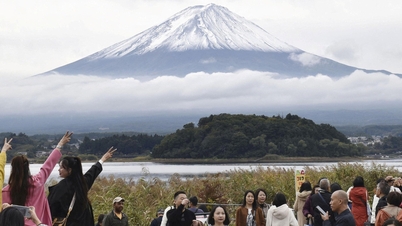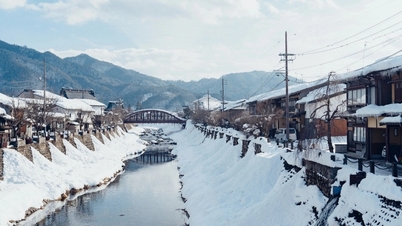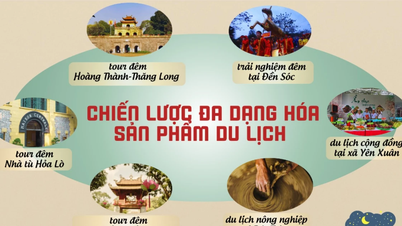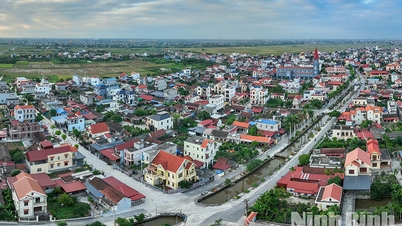According to a VNA reporter in Tokyo, the Fuji Five Lakes area (Fujigoko) in Yamanashi province (Japan) has long been considered one of the most typical landscape complexes to admire Mount Fuji.
Each season brings its own unique characteristics, but Autumn is considered the time when the landscape reaches its clearest harmony. From the yellow of the ginkgo trees, the red of the maple forest to the deep blue of the lake, all create a natural picture rich in depth, elegance and balance.
This year, due to the impact of climate change, winter came earlier, causing the red and yellow leaf season in the Five Lakes region to also come earlier than every year.
However, that brings a unique experience to visitors: admiring the brilliant colors of Autumn in the chilly early winter weather, when mist covers the lake surface and the first snow of the season appears on Mount Fuji.
The journey to discover Mount Fuji in Autumn often starts from Lake Kawaguchi - where transportation is convenient and the service system is most developed.
In October and November, both sides of the lakeside road light up with rows of golden ginkgo trees, fallen leaves covering the path, reflecting the gentle sunlight of early winter days.
The most prominent is the Momiji Tunnel on the north shore of the lake - where the ancient maple trees intertwine to form a bright red dome. When passing through this "tunnel", visitors feel like they are passing through the gate of the seasons, where time is dyed in a warm red color.
Leaving Kawaguchi, the journey leads to Lake Sai - a place with a quiet and calm landscape. The space here is surrounded by maple and birch forests changing colors, blending with the deep blue water, creating layers of red, yellow and dark green.
The calm lake surface fully reflects the image of Mount Fuji, especially in the morning when the mist slowly melts, making the mountain's graceful shape appear against the pale sky.
Amidst that scene, the ancient village of Iyashi no Sato Nenba appears on the lakeside as a highlight of traditional culture.
The village, with more than 20 thatched-roof houses restored after a landslide in 1966, now serves as a reminder of old Japan. Visitors can dress in kimonos and samurai armor, or take part in classes on making washi paper, pottery, and traditional crafts.

Mount Fuji seen from the south. (Photo: Xuan Giao/VNA)
As the sunset falls, blue smoke rises from the thatched roofs, making the Saiko painting even more ancient, reminiscent of the peaceful beauty of the Japanese countryside during the Edo period.
Next on the journey is Lake Shoji, the smallest lake but offers the clearest reflection of Mount Fuji. Thanks to its small size and flat surface, the mountain appears almost perfectly symmetrical.
When autumn comes, the trees around the lake change color simultaneously, creating distinct layers of color - yellow at the top of the hill, red in the middle of the slope and dark green at the foot - reflecting on the water surface, like a natural oil painting.
Shoji remains pristine, with little human impact, making it a favorite destination for those seeking tranquility and contemplation.
The journey ends at Lake Motosu, famous for its deep blue waters all year round. The purity and depth of the lake mean the water remains blue even after autumn has passed.
Here, the image of Mount Fuji reflecting on the lake surface was chosen to be printed on the back of the old 1,000 yen note - a symbol affirming the aesthetic and cultural value of this landscape in the Japanese mind.
In the morning, when the early sunlight reflects on the water surface and white snow begins to cover the mountain tops, the entire scene is covered with the clear blue of the sky and water, creating a solemn and spacious feeling.
Although autumn in Fuji Five Lakes is short-lived, recent climate change has made the cycle even shorter, but that brevity adds to the value of the moment: every falling leaf, every layer of mist becomes part of the symphony of colors that nature has to offer.
The yellow of ginkgo, the red of momiji, the blue of the lake and the white snow looming on the mountain top - all blend into a harmonious scene, symbolizing the "romantic" aesthetic spirit of the Japanese people.
Fuji Five Lakes in Autumn is not only a destination for sightseeing, but also a space to feel the harmony between people and nature, between the past and the present. In the chilly weather of early winter, when the maple leaves are still bright red and the snow has begun to fall, the journey from Kawaguchi to Motosu is like a symphony of colors in the gentle sound of the wind and the forest./.
(TTXVN/Vietnam+)
Source: https://www.vietnamplus.vn/nhat-ban-sac-thu-ruc-ro-cua-vung-nui-phu-si-trong-tiet-troi-se-lanh-dau-dong-post1076663.vnp







![[Photo] Deep sea sand deposits, ancient wooden ship An Bang faces the risk of being buried again](https://vphoto.vietnam.vn/thumb/1200x675/vietnam/resource/IMAGE/2025/11/13/1763033175715_ndo_br_thuyen-1-jpg.webp)
































































![[Photo] Panorama of the 2nd Vietnam-Cambodia Border Defense Friendship Exchange](https://vphoto.vietnam.vn/thumb/402x226/vietnam/resource/IMAGE/2025/11/13/1763033233033_image.jpeg)

























![Dong Nai OCOP transition: [Article 3] Linking tourism with OCOP product consumption](https://vphoto.vietnam.vn/thumb/402x226/vietnam/resource/IMAGE/2025/11/10/1762739199309_1324-2740-7_n-162543_981.jpeg)







Comment (0)